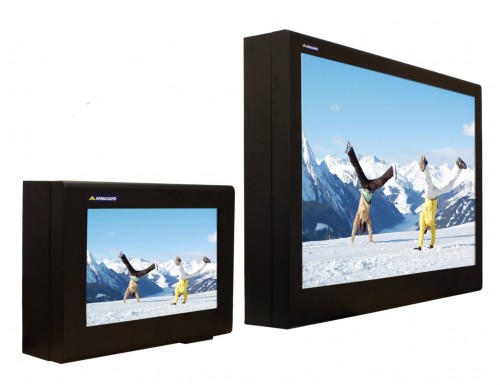Temperature Concerns for Outdoor LCD Screens
Posted by: Richard Williams | Posted on: | 0 Comments
When most people think of protection for outdoor digital signage, automatically their mind turns to IP65 or NEMA 4, and how the screen needs waterproofing. While waterproof protection to these rating systems is an essential aspect to using an outdoor LCD, other aspects of using Outdoor LCD Screens are just as important.
IP65 and NEMA 4 are internationally recognised rating systems that denote the ability of a screen enclosure to withstand moisture; however, neither system takes into account the requirement of an LCD TV to remain within set temperature parameters when it is functioning.
LCD TVs are extremely susceptible to temperature. The backlights in most LCDs generate large amounts of heat, which is important to expel. This is why most LCD screens have air vents at the rear. This venting system proves problematic when taking LCDs outdoors, as any waterproof protection needs to allow the heat to escape from the LCD whilst also preventing any moisture from getting inside.
In normal conditions, this is tricky enough requiring use of cooling fans to suck air in, baffled chambers to provide access for air and not water, and further fans to expel the hot air. Some modern LCD screens that use LED backlights help alleviate the problem over overheating as the backlights generate a lot less heat and require fewer fans for cooling.
In locations where high seasonal temperatures occur, however, the problem of overheating is often not caused by the heat generated from the LCD but by the ambient conditions. In high heat locations, additional fans are often required to prevent the screen overheating, and in some extreme locations that suffer exceptionally high levels of ambient temperature, even air-conditioners need considering.
In cooler climes and in wintry locations, the opposite problem to overheating can become just as much as a problem for outdoor screens, especially for those screens facing sub-zero temperatures. LCD screens faced with freezing temperatures can fail as the extreme cold can cause contraction and may lead to components cracking.
For these locations, thermostatically controlled heaters are a simple solution that maintains the internal temperature of the enclosure when temperatures plunge below zero. Some extreme locations where arctic temperatures occur throughout the year require even more cold protection, and in these cases, the use of insulation helps ensure the enclosure can keep a stable temperature above zero.
Because of this flexibility and customisation, LCD enclosures provide a solution for temperature control for almost any environment, enabling LCD screen use in even the most extreme of outdoor locations.
Post shortlink:
Popular Products
LCD Enclosure
Need armor for your LCD/LED screen(s)? Outdoors or inside the versatile LCD enclosure protects against thieves, vandals & the weather. Installation idea: NFL stadiums.
Outdoor Digital Signage
Exclusive 46” outdoor screen protection. Dubbed the ‘Totem’, due to its distinct design, it repels damage threats, but attracts audiences. Installation idea: Drive-thru restaurants.
Portrait Flat Panel Enclosure
Safeguard your eye-level advertising display screen(s), indoors or outdoors. Completely customizable, add exciting features like touch screen technology. Installation idea: Restaurant frontages.
Indoor Digital Signage
Popular purchase for retail outlets! Great for ‘point of sale’ persuasion, boost your brand with static & motion advertising from a single unit! Installation idea: Mall of America.





